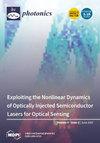FSOC 系统中的自适应比特交织极性编码调制性能
IF 1.9
4区 物理与天体物理
Q2 OPTICS
引用次数: 0
摘要
本文提出了一种基于最小对数上限权重(MLUW)的自适应位交织极性编码调制(A-BIPCM)方法。该方法旨在减少自由空间光通信(FSOC)中由大气湍流引起的衰减效应和长串误码干扰。为了评估这种方法在不同强度的湍流信道中的有效性,我们对湍流信道中极地编码的误码率(BER)性能进行了评估。结果表明,与传统极性码编码和解码相比,A-BIPCM 方法的性能有了显著提高。具体来说,在弱湍流、中等湍流和强湍流条件下,A-BIPCM 方法的性能分别提高了 0.96 dB、1.66 dB 和 1.35 dB。此外,本研究还建立了一个采用强度调制直接探测(IM/DD)的 FSOC 实验验证平台,该平台具有大气湍流模拟通道。当探测器的光功率为 -16 dBm 时,传统极性码编码和解码的误码率为 2.36 × 10-5,而 A-BIPCM 方案的误码率为 2.11 × 10-6,性能明显更高。误码率提高了一个数量级。本文章由计算机程序翻译,如有差异,请以英文原文为准。
Performance of Adaptive Bit-Interleaved Polar Coded Modulation in FSOC System
This paper proposes an adaptive bit-interleaved polar coded modulation (A-BIPCM) method based on minimum logarithmic upper bound weight (MLUW). It is designed to reduce the fading effects and long string of bit error interference caused by atmospheric turbulence in free-space optical communications (FSOC). To assess the effectiveness of this method across turbulent channels of varying intensities, we conducted an evaluation of the bit error rate (BER) performance of polar codes in turbulent channels. The results demonstrate significant performance improvements provided by the A-BIPCM method compared to conventional polar code encoding and decoding. Specifically, under weak, moderate, and strong turbulence conditions, the A-BIPCM method achieves performance gains of 0.96 dB, 1.66 dB, and 1.35 dB, respectively. Additionally, an experimental verification platform for FSOC employing intensity modulation direct detection (IM/DD) with an atmospheric turbulence simulation channel, is established in this work. When the optical power of the detector is −16 dBm, the traditional polar code encoding and decoding performance at BER = 2.36 × 10−5, whereas the A-BIPCM scheme exhibits a significantly higher performance at BER = 2.11 × 10−6. The BER has been improved by representing an order of magnitude.
求助全文
通过发布文献求助,成功后即可免费获取论文全文。
去求助
来源期刊

Photonics
Physics and Astronomy-Instrumentation
CiteScore
2.60
自引率
20.80%
发文量
817
审稿时长
8 weeks
期刊介绍:
Photonics (ISSN 2304-6732) aims at a fast turn around time for peer-reviewing manuscripts and producing accepted articles. The online-only and open access nature of the journal will allow for a speedy and wide circulation of your research as well as review articles. We aim at establishing Photonics as a leading venue for publishing high impact fundamental research but also applications of optics and photonics. The journal particularly welcomes both theoretical (simulation) and experimental research. Our aim is to encourage scientists to publish their experimental and theoretical results in as much detail as possible. There is no restriction on the length of the papers. The full experimental details must be provided so that the results can be reproduced. Electronic files and software regarding the full details of the calculation and experimental procedure, if unable to be published in a normal way, can be deposited as supplementary material.
 求助内容:
求助内容: 应助结果提醒方式:
应助结果提醒方式:


